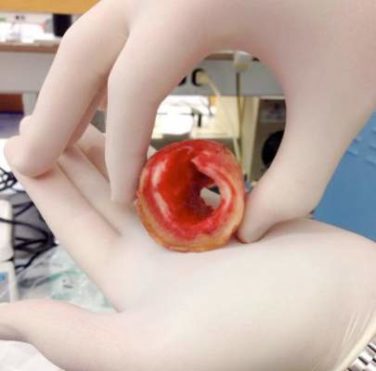AT MIDWESTERN VASCULAR 2015
CHICAGO (FRONTLINE MEDICAL NEWS) – Drug- and device makers paid $3.4 billion to U.S. physicians and hospitals in the last 5 months of 2013, according to first-year data from the Centers for Medicare & Medicaid Services (CMS) Open Payments program, Dr. John Blebea reported at the annual meeting of the Midwestern Vascular Surgical Society.
The Open Payments program is the first step by the federal government toward transparency on the financial relationships between physicians and drug- and device makers and is charged with providing data that is both understandable by the public and searchable for individual physicians.
Under the Physician Payments Sunshine Act, a provision of the Affordable Care Act, manufacturers of drugs, medical devices, and biologics that participate in Medicare and Medicaid are required to report any payments or transfers of items with a $10 onetime value or $100 cumulative annual value to nonresident physicians and teaching hospitals.
Dr. Blebea and his colleagues at the University of Oklahoma in Tulsa sought to examine payments made to vascular specialists during the first year of the Open Payments program using data available from August 2013 to December 2013.
Nationally, 1,347 companies paid $2.9 billion (85%) to 470,000 physicians and $599 million (15%) to 1,019 hospitals during that period. Almost half of payments to physicians ($1.19 billion) was for research; $735 million was for food, travel, honoraria, and consulting services, and about one-third ($908 million) was in stock ownership or investments, Dr. Blebea said.
The investigators also looked at data from New York alone, where payments varied widely among specialties. Four vascular surgeons and one cardiologist reported ownership or investment interests totaling $1,092,025 and $98,689, respectively, but the data were skewed because one vascular surgeon had investment stock valued at $1,033,728, Dr. Blebea said.
Research grants were uncommon among the 223 vascular surgeons, 229 interventional cardiologists, and 88 radiologists and valued at just $4,250, $5,372, and $8,532.
General payments were significantly different between the three groups ($1,808,890 vs. $534,688 vs. $73,492; P less than .0001), he said. This averaged $3,196 per vascular surgeon, $1,889 per cardiologist, and $738 per radiologist. But, again there were broad variations in the data, resulting in medians of $279, $99, and $116, respectively.
One could argue that $279 isn’t a lot in terms of payments for services made or received, but a small number of vascular surgeons did receive what one could argue is a significant amount of money, Dr. Blebea said. Specifically, 8% received more than $5,000 over the 5 months, and three received more than $100,000.
“So you could ask the question: ‘Could this induce bias in scientific presentations?’ and you could answer, ‘Maybe yes, maybe no,’ ” he said. “But what about the three individuals who received more than $100,000? The answer there is that they are probably more likely to be consciously or unconsciously biased in their presentations.”
Dr. Iraklis Pipinos of the University of Nebraska, Omaha, questioned the number of specialists in the New York analysis, noting that he would expect the number of cardiologists to be four to five times that of vascular specialists.
“It’s an important point and I share your concern,” Dr. Blebea responded. “In actual fact, how people are reported in terms of their specialties is how the companies categorize you, so the data may not be completely accurate. It’s one of the challenges.”
Industry groups and professional societies have raised concerns about the incompleteness of the Open Payments data and argued that inaccuracies could harm reputations and undermine trust between patients and their physicians.
Physicians have 45 days after the data submission period to review their Open Payments data and dispute errors before the information is released publicly. Errors can be contested after the deadline has passed, with corrections made in the next reporting cycle.
Still, of the 4.3 million payments made nationally in the last 5 months of 2013, only 1,145 payments (0.02%) worth just $6.25 million were contested, Dr. Blebea reported.
“So it’s either accurate or most physicians didn’t bother to contest inaccuracies,” he said, adding, “I certainly did [contest the data] because there was an inaccuracy in what was reported for me and that was corrected, but how many people will correct these in the future? I hope everybody does.”
Of the $6.49 billion paid to physicians and hospitals in 2014, physicians have disputed only $5.06 million in general payments and $13.16 million in research payments, according to 2014 data reported by the CMS .
Dr. Daniel G. Clair, chair of vascular surgery at the Cleveland Clinic, commented that contrary to what the analysis suggests, it isn’t easy to distinguish between research dollars and nonresearch dollars and between payments made to an institution versus those made to an individual.
“I work for a facility where I am a salaried professional and contracts for some of these things are negotiated between the institution and the company. I’m completely left out of it, but because I happen to be the individual who provides services, it looks like that money is coming to me,” he said.
To provide more transparency in payments, Dr. Blebea said he would recommend quantitative disclosure of industry payments at scientific meetings and in publications with reporting of a range of payments, such as less than $1,000, $1,000-$5,000, $5,001-$10,000, and more than $10,000, rather than specific amounts.
Dr. Blebea and Dr. Pipinos reported having no relevant financial disclosures. Dr. Clair reported serving on the data and safety monitoring board for Bard, as an advisory board member for Boston Scientific and Medtronic, and as a consultant for Endologix.




